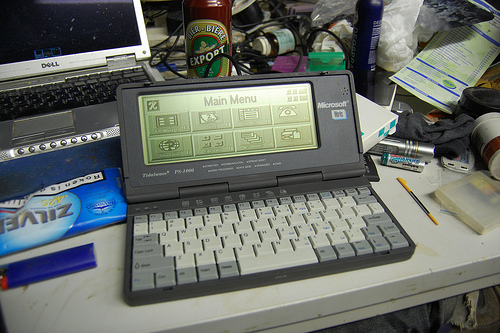DOS Palmtop: ProLinear PS-1000 Details and specs
ProLinear PS-1000 (ProLinear PS-1000 MiniNote)

About this machine:
Pretty much everything has been said about the Tidalwave PS-1000, but one really noteworthy "clone" is the ProLinear
PS-1000. If there is a prize for the lamest "clone" or "OEM" version then this one should claim it. If you ordered the
ProLinear PS-1000 MiniNote in around 1992-1993 you would just get a normal Tidalwave PS-1000. No branding, nothing.
That makes even the arguably lame branding by "MASTER" look awesome. To understand that we have to look a bit closer
at ProLinear as a company. ProLinear was a small garage company from Arcadia in California. Just like the "big players"
like Zeos, Sharper Image and all the others they probably somehow got into contact with Tidalwave, probably since
Tidalwave seems to have been looking for distributors quite aggressively. So not much surprising that suddenly the small
garage company from California could offer "their own" palmtop with same specs as the ZEOS for the "typical" price
of 595 USD. As there is no branding at all practically you can argue that "there is no Prolinear PS-1000" if you look
at it like this. I think most of the Tidalwave PS-1000 that are around in the US were bought as "ProLinear" ones, but
due to the lack of any branding this is obviously hard to prove. Fact is that ProLinear - unlike their big competitors -
also offered the follow up model by Tidalwave. The PS-3000 was announced in April 1993 for 1095 USD and shipped in May 1993.
my guess is that while the big competitors had loads of unsold stock of the PS-1000 clones ProLinear probably only had a rather
small amount of stock and thus didn't suffer from losses, so they could afford to introduce the 386-based PS-3000 model
with an ease. I think ProLinear was a one-man show. they also sold some RAM, modems, Flash cards and even a pentium based Notebook
but disappeared somewhere in around 1996.
Specs:
CPU: NEC V30 @ 7.15 MHz
Graphics: Monochrome CGA, 80 x 25 character text mode, CGA 2 color monochrome graphics mode
Display: 640 x 200 monochrome Supertwist LCD , 4 grey scales, 7.2 inch
Memory (RAM): 1 MB
ROM (Software): 1.5 MB
I/O ports: RS232 Serial (proprietary cable was included accessory), PCMCIA 1.0 Type I slot, Parallel port (proprietary cable included)
Sound: PC Speaker - Piezo
Operating System: MS-DOS 5.0
Software: MS Works 2.0, RacePen PIM (File manager, scheduler, phone book, etc), Microsoft QBasic
Size: Length 11.5 cm, Width 24.5 cm, Height 2.5 cm (4.5 inches x 9.7 inches x 1 inch)
Powered by: 2 AA batteries - rechargable or non-rechargable or AC adaptor (optional accessory), CR2032 Lithium button cell as memory backup
Weight: 590 gram (21 ounces) including 2 standard AA and CR2032 batteries
Special features: None
Released: 1992
Originally retailed for:: 595 USD
Clone of: Not a clone. However all other models based on it can be considered clones.
Similar models: Zeos Pocket PC, Highscreen Handy Organizer and all other clones
Pros:
- Fully CGA compliant, so most CGA based DOS appz and games work
- Excellent keyboard
Cons:
- No support for flash cards
- Not really the smallest Palmtop ever
- Power management is rather average
- No way to boot a different OS and no way to bypass loading the drivers for cards and keyboard
Collector Value:
8 of 10
Usage Value:
7 of 10
Verdict:
Give it a usability value of 10/10 if you don't care about CF cards. The original is also unfortunately one of the rather rare palmtop models. However if
you don't care about the brand name on the lid you can also get any of the clones and have the exact same machine. The large keyboard and display
along with the useful MS Works make this a quite useful companion in any edition.
Back to the Palmtop PC index
